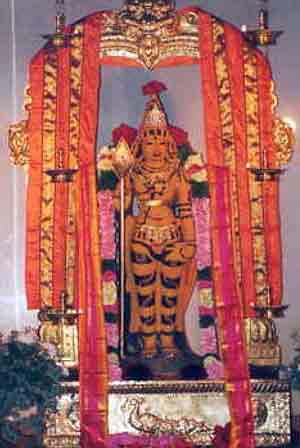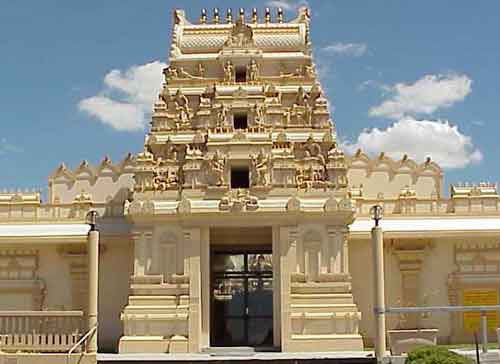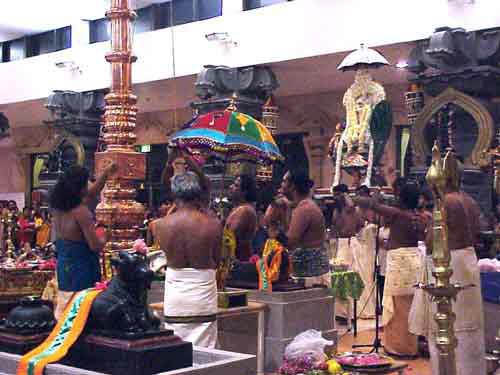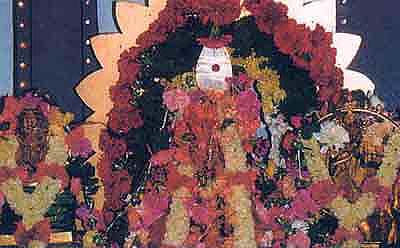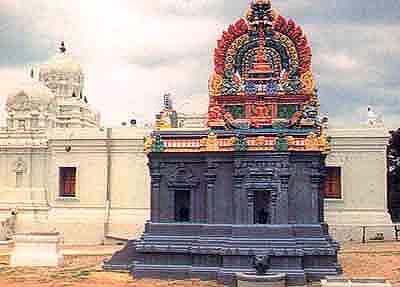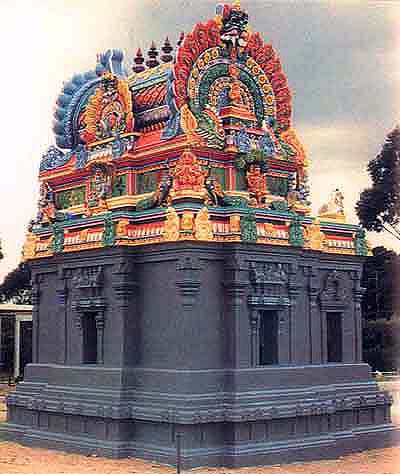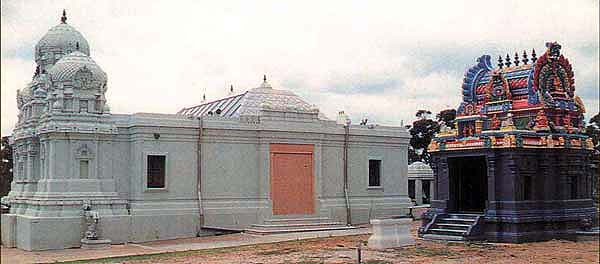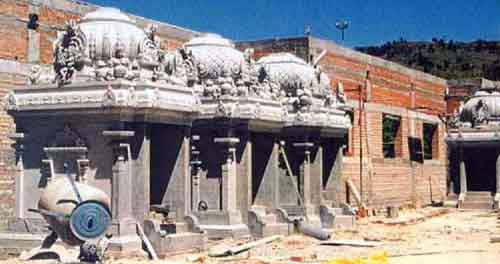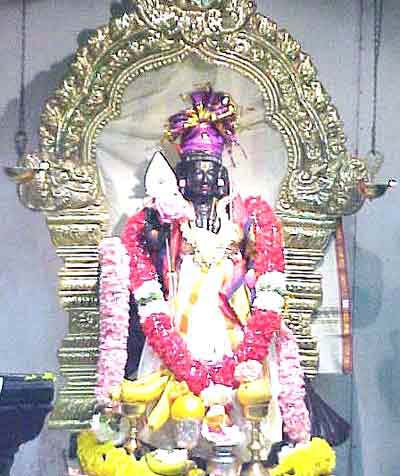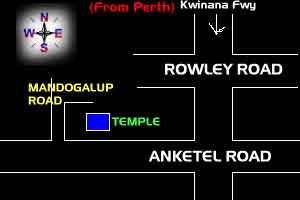
|
|||||||||||||||||||||||||||||||||||||||||||||||||||||||||||||||||||
|
| |||||||||||||||||||||||||||||||||||||||||||||||||||||||||||||||||||
Murukan worship in AustraliaDr Arumugam KandiahIntroduction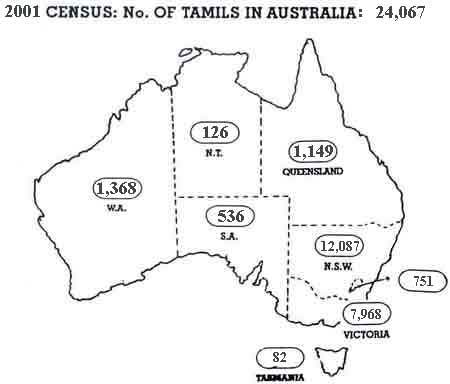
Australia is the smallest and world's oldest continent, inhabited for more than 40,000 years by Aborigines. It was settled by the British barely 200 years ago from 1788 onwards and since then has transformed from a colonial outpost into a nation with a population of more than 18 million. For visitors, its ancient, worn landscape contrasts with the vitality and youthful energy of its inhabitants. Australia is a multi-lingual, multi-religious and multicultural country. Nearly a hundred nationalities live in Australia and nearly a hundred languages are spoken. Australians have the freedom to express and practice their diverse religious beliefs in an environment that is both accepting and tolerant. As a multicultural country it is a paradise for the Tamil Hindus to foster and maintain their language, culture and religion. Prior to 1981 there were approximately 1000 Tamils living in Australia. This number increased year by year. Similar to the other ethnic groups the Tamil community also established centres of cultural and religious significance for themselves in the states and territories in Australia where they have migrated. As an educated community within a short period of their arrival they started building temples of their own. The Śrī Venkateswara Temple at Helensburgh in NSW was the first Hindu temple to be built in Australia. This temple satisfied the immediate needs of the Hindu communities in Australia. Australia consists of six States: New South Wales (N.S.W), Victoria (Vic.), Western Australia (W.A.), Queensland (QLD), South Australia (S.A.) Tasmania (Tas.) and two Territories: Australian Capital territory (A.C.T.) and Northern (N.T.). There are Tamils living in all the states and territories; approximately 90% of the Tamils are Saivites. After 1994 they started building temples for Lord Śiva, Vinayagar and Murukan. Australia's 1996 census of population stated that 18,690 Tamils were living in Australia at the time. The table below from the 1996 census shows the number of Tamils living in the six states and two territories in Australia:
According to a private survey conducted by the author there are now nearly 30,000 Tamils in Australia. The interesting feature is that the number of Tamils living in the state of New South Wales is nearly half the total Tamil population of Australia. The above table shows that out the 18,690 Tamils in Australia there are 9,072 Tamils living in NSW and 6,251 Tamils in Victoria. There are Hindu temples in all the states and territories except in the state of Tasmania. There are more than one Hindu temple in NSW, Victoria and Western Australia. But Murukan temples are in three states, namely New South Wales, Victoria and Western Australia and also in one territory, namely the Australian Capital Territory. Murukan Temple in New South WalesLord Murukan in the state of NSW resides at Mays Hill, a local eminence in Sydney, the capital of New South Wales. The Lord is popularly known as 'Sydney Murugan'. Murukan is the lord of the hill region and his abode is usually located on hills. 'Sydney Murukan' also resides in the hill region called Mays Hill, which presently called by the Tamils as vaikacik kunru. Murukan worship in Sydney was originally initiated by Mr. Śivajoti Danikai Skandakumar, a Sri Lankan Tamil who brought a statue of Murukan made of five metals, viz. gold, iron, copper, lead and silver, from Jaffna, Sri Lanka in 1983. Inviting a number of devotees, he commenced worshipping the Lord at his residence in Sydney and later on Fridays in 1986 this
In 1985 a Hindu society, the Saiva Manram, was formed in order to build a temple for Lord Murukan. Since its inception, Lord Murukan has been called 'Sydney Murukan'. The Saiva Manram has worked hard for nearly ten years to build a temple for Lord Murukan.
In 1990 the Saiva Manram bought a plot of land from the Roads and Traffic Authority. This site was between two highways and does not have residences on three sides. This land is located in a suburb called Mays Hill about ten kilometres from Strathfield. This land was originally bought to build a Tamil cultural centre with the idea of conducting prayer meetings for Lord Murukan. In September 1994 the foundation stone was laid for the Sydney Murukan Temple and Tamil Cultural Education Centre. On this foundation at Mays Hill in the heart of the western region of Sydney the construction works for the temple commenced in April 1997. Here the Saivaites in New South Wales built a magnificent temple for Lord Murukan. The main shrine has three chambers; the middle one for the main deity, 'Sydney Murukan' and either side is for Śivan and Ambal. In other words, in the sanctum sanctorum of the Sydney Murukan Temple the statue of Murukan is enshrined as the main deity. The consecration ceremony of `Sydney Murukan' was performed on 17 June 1999. Murukan is associated with hill country and He resides on hills. Sydney Murukan also has chosen Mays Hill as his abode. It is remarkable that this temple had its annual festival before its first anniversary of the mahakumbhabhishekam (pouring the sanctified water, etc. over the pot-like structure on the tower and over the main deity at the time of installation). The Sydney Murukan Temple provides great opportunities for the Hindus in Australia, particularly those in Sydney to serve the community in many ways. From the inception of the Saiva Manram in 1985 the following members functioned as president and served during the construction of the Sydney Murukan Temple:
Murukan Temple in VictoriaMurukan worship in the state of Victoria was initiated by Mrs. Mani Selvendra, a Śrī Lankan Tamil who brought a Vel made of five metals, viz. gold, iron, copper, lead and silver from Jaffna, Sri Lanka. In 1991 a committee was formed and prayers were held in community halls and houses in Melbourne. According to Mani Selvendra, she initiated building a temple for Lord Murukan in Melbourne to fulfill the aspiration of her father Mr. V. Thambinayagam, who was a devotee of Lord Murukan. A cultural centre was formed in 1995 in order to build a temple for `Melbourne Murukan'. Under the chairmanship of Mr. Ganeshamoorthy, the Cultural Centre took the initiative and completed the first stage of the Murukan Temple at Knight Avenue in Melbourne in the state of Victoria. The opening ceremony of this temple was held with cankapisekam - ceremonial bath of an idol with chanks (conch shells) filled with sacred water - on 23 January 1999. Since its inception, Lord Murukan was called `Melbourne Murukan'. In the sanctum sanctorum of the Melbourne Murukan Temple originally the Vel (spear) has been the object of worship. Worshipping the Vel is the tradition at the Murukan temple at Nallur, Jaffna, Sri Lanka. But according to the Melbourne Cultural Centre, a Murukan statue will also be enshrined in the sanctum sanctorum of the Melbourne Murukan Temple. The Melbourne Murukan Cultural Centre is working hard to complete the last three stages of the temple to perform the consecration ceremony as early as possible. Śrī Subramania Swami Temple in NSWThe Śrī Subramania Swami Temple is located within the Śiva Temple complex at Helensburgh, a suburb about 50 kilometers from Sydney in New South Wales. It is rare and unique to have Saiva and Vaishnava temples side by side. At Helensburgh there are two temple complexes side by side, the Śiva temple complex and the Venkateswara temple complex. In the former complex there are shrines for Śiva, Parvati, Murukan, Valli, Teyvayanai, Durukambigai, Dakshinamurti and Navakkiraka deities and in the latter within the main temple of Venkateswara there are shrines for Mahālakshmi, Andal, Rama, Sita, Lakshman and Anjaneya. The consecration ceremony for the Śrī Subramania Swami Temple at Helensburgh along with Śiva, Parvati, Valli, Teyvayanai took place in January 1994. An icon of Śrī Subramania Swami is enshrined in the sanctum sanctorum. In the Mahākumbhabhiseka souvenir publication Śrī Subramania Swami with his consorts is interpreted as follow: "He is the other son of Śiva. He is also known as Karttikeya, Skanda, Shanmukha or Murukan. As Shanmukha, the six-headed, He teaches that we have five senses and the mind, and only when all are in harmony can there be spiritual growth. In this temple He will be known as Śrī Subramania Swami, representing the personification of Vedic knowledge leading to liberation. He has two consorts, Valli and Devasena. Devasena personifies the gradual liberation aspect. Valli represents the instantaneous liberation aspect. Thus Veda is Subramania and two pathways to liberation are His consorts, Valli and Devasena. He rides the peacock, reminding us not to let pride and egotism get the better of us." Australia is a multicultural and tolerant country so it is more appropriate to have Saiva and Vaishnava temples side by side under the Śiva and Venkateswara temple complexes in the same compound. The Śrī Venkateswara Temple in Helensburgh in NSW, which was consecrated in 1985, was the first traditionally designed Hindu temple to be built in Australia.The Śrī Subramania Swami Temple within the Śiva Temple Complex was consecrated in 1994. Therefore, it can be regarded as the first Murukan shrine built in Australia according to the agama sastras.
Murukan Temple in the Australian Capital TerritoryThe Canberra Murukan Temple is located at 151 Beasley Street, Torrens in the Australian Capital Territory. The first stage of the Canberra Murukan Temple was completed in November 1996. The consecration ceremony was performed for a number of deities including Lord Murukan in November 1997.
The main temple is being constructed according to agamas by an Indian sthapati - one who knows the art of constructing temples. It will house Vinayagar, Civan, Murukan, Valli, Teyvayanai as the main deities and other deities including Mahā Vishnu, Śrī Devi, Bhu Devi, Nadarajar, Amman, Durga, Lakshmi, Sarasvati, Vairavar and Navagriham - nine deities presiding over the nine planets. The main temple construction is well under way and will be completed soon to hold the consecration ceremony. The special feature of this temple is that it will contain six separate shrines for Lord Murukan depicting his six abodes. According to the Canberra Murukan Temple Appeal published by the Canberra Saiva Temple and Educational Association, Lord Murukan will be housed in six abodes consisting of a large sanctum sanctorum and five other large shrines depicting Lord Murukan's forms as in Tiruttani, Tirupparankunram, Tiruccentur, Palani, Swamimalai and Palamutircolai in Tamil Nadu. Like Sydney Murukan in NSW and Bala Murukan in Western Australia, Canberra Murukan has also chosen a relatively elevated place with hills at the background nearby. The Canberra Murukan Temple is owned and managed by a non-profitable religious organization, the Canberra Saiva Temple and Educational Association. The objective of this association is to build and maintain the Saiva temple, the library and the educational centre to enhance the Saiva religion. Two directors, Mr. S. Mylvaganam and Mr A. Jegatheeswaran and one managing director, Mr N. Manoharan, are the key people leading a dedicated team of 26 members in the construction and management of the Temple and Educational Centre. The Canberra Saiva Temple and Educational Association is a proprietary limited liability company with strict clauses in its constitution to prevent changes to its objectives and to prevent any one from deriving any profit. The directorship and membership of the committees are open to all devotees without any distinction, who are willing to genuinely serve the association. The devotees can participate as yajamanas in the consecration ceremony. Bala Murukan Temple in Western AustraliaBala Murukan Temple is situated on Mandogalup Road, Mandogalup, some 38 kilometers south of Perth in the state of Western Australia. The temple is located on a high sand dune (kunru) in an area of about five acres in a lush green environment. It resembles the temples of Tamil Nadu in every respect. It is remarkable that as the Lord of the hill region, Bala Murukan in the State of Western Australia also resides on a high sand dune. His abodes are usually located on hills.
The worship of Bala Murukan in the state of Western Australia was begun in August 1996. There was a building in the premises of the temple land that was purchased by the Saiva Mahā Sabai. This building was converted into a sacred temple in which Bala Murukan and other deities were installed and consecrated. A Hindu priest performs daily pujas for Bala Murukan and other deities. The location map of the temple is provided at figure below. In 1996 a Saivite society, the Saiva Mahā Sabai, was formed in order to build a temple for Murukan. The Saiva Maha Sabai of Western Australia (Inc) owns the Bala Murukan Temple. The membership of Saiva Maha Sabai is open for all Saivites of Western Australia without any restriction of membership contribution. At present sixty Tamil families are members in the Saiva Maha Sabai. About 50 to 75 devotees participate in the weekly Friday special puja. Other festivals such as Taipponkal, Taippucam, Tamil New Year, etc. are attended by hundreds of devotees. A new temple is now under construction in the temple land in a cost of A$ 1.5 million. The total plinth area of the temple is 1350 square metres. The shrine of Bala Murukan will have a ten-meter high tower (gopuram); there will be separate shrines for each of the other deities in the temple. A 15-meter high rajagopuram - the tallest tower at the east gate - will be constructed. The new temple is expected to be completed within two years. The Bala Murukan temple's elevated landscape with the raja gopuram will make the new temple a landmark building south of the city of Perth in the state of Western Australia.
The Saiva Maha Sabai is presently engaged in constructing a Tamil Cultural Centre in Western Australia and the Bala Murukan Temple will be the centre of its cultural activities. The Saiva Maha Sabai has plans to construct a retirement village near the temple, which will help immensely in the day-to-day activities in the temple. The retirement village is expected to be an attraction for older Tamil Australians. Dr R. Rajagopalan, the benevolent philanthropist, has been the President of Saiva Maha Sabai from the day of its inception. Dr R. Rajagopalan and Mrs. Chelli Rajagopalan are the key persons leading a devoted team in the construction of the temple and cultural centre. Traditional Hindu temple architectureThough temples are built in Australia according to cirpa cattiram -- science of architecture, sculpture and other allied branches of art -- it should be strictly constructed according to akama cattiram, a class of sacred works in Sanskrit, Saiva, Vaishnava, Shakta or Jaina. The structure and appearance of a Hindu temple have deep meaning. Hindus in foreign countries, whether they are Saivites or Vaisnavites, have to build their temples either small or big according to akama cattiram for the people of other religions to understand the inner meaning of Hindu temple architecture. For example, Ponnambalavaneshwarar Civan Temple in Colombo, Sri Lanka, is a magnificent temple built by Sir Ponnambalam Ramanathan according to akama cattiram. There are many Hindu temples built according to akama cattiram in Tamil Nadu. Foreigners admire the architecture of those temples whenever they visit. Peoples of the East and West admire the beauty and the inner meaning of the Hindu temple built according to akama cattiram. The art of temple building, carving of statues, the method of selecting rocks and stones for the statues, the method of enshrining the statues, the decorations of the paved way around the sanctum sanctorum, constructing the towers are all described in detail in the cirpa cattiram. The Hindu temple is also the venue for all kinds of cultural activities. It is a meeting place for all the people without any distinction between young or old, high or low, rich or poor, educated or uneducated. There is no room for political or sectarian interests or feelings. The atmosphere of the temple should be conducive to peace and harmony. ConclusionThis study of Murukan temples in Australia has shown how the worship of Murukan has developed into its full form in Australia. There was neither congregational Murukan worship nor a Murukan temple in Australia prior to 1985. According to the census of population and housing prior to 1985, the number of Tamils living in Australia was then less than 3500. From our survey we can reasonably conclude that the worship of Murukan in Australia was originally initiated in the form of congregational prayer. Later those who participated in the prayer meetings formed associations to build temples for the Lord. At this stage two interesting facts have come to light; one is that Sri Lankan Tamils are in the forefront of initiating and building temples for Lord Murukan. The other is that the worship of Murukan is prevalent among Sri Lankan Tamils. In Sri Lanka, particularly in the North, there are many Murukan temples and Murukan worship is prevalent. Out of the five temples surveyed above, four temples -- the Sydney Murukan Temple, the Melbourne Murukan Temple, the Canberra Murukan Temple and the Bala Murukan Temple -- were initiated and built by Sri Lankan Tamils. According to the 1996 census, of the total Tamil population in Australia nearly 70% are Sri Lankan Tamils and approximately 90% of the Tamils are Hindus. References
Dr. A. Kandiah, Ph.D. (London) is language specialist at the Institute of Languages, University of New South Wales, Australia. In his 35 years of teaching and research experience, he has published over 25 books. Contact the author: 17, Edward Street South Strathfield NSW 2136, Australia E-mail: akandiah@one.net.au Contact sydneymurugan@yahoo.com. Murugan Worship in Melbourne |
|
|
